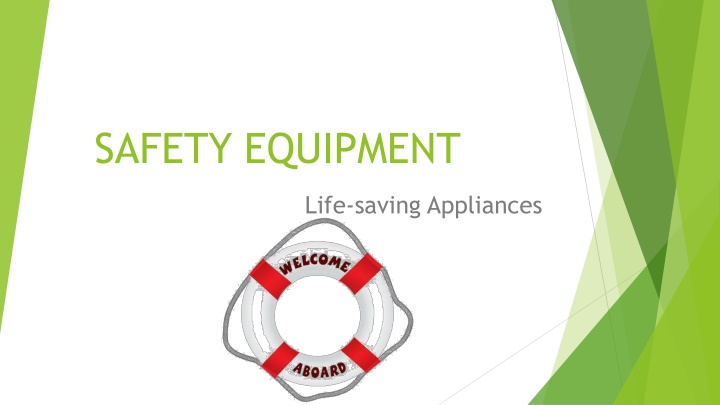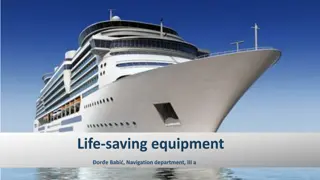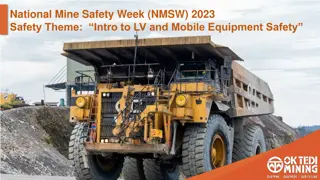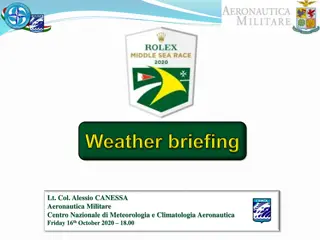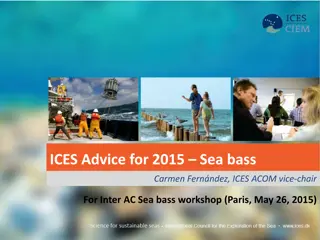Essential Life-saving Equipment Overview for Safety at Sea
Life-saving appliances such as lifebuoys, lifejackets, immersion suits, visual signals, buoyant smoke signals, survival crafts like liferafts and lifeboats are crucial for ensuring safety at sea. Each equipment serves a specific function, from aiding in rescue operations to providing thermal protection and signaling distress. Understanding the proper use and maintenance of these appliances is vital for maritime safety.
Download Presentation

Please find below an Image/Link to download the presentation.
The content on the website is provided AS IS for your information and personal use only. It may not be sold, licensed, or shared on other websites without obtaining consent from the author.If you encounter any issues during the download, it is possible that the publisher has removed the file from their server.
You are allowed to download the files provided on this website for personal or commercial use, subject to the condition that they are used lawfully. All files are the property of their respective owners.
The content on the website is provided AS IS for your information and personal use only. It may not be sold, licensed, or shared on other websites without obtaining consent from the author.
E N D
Presentation Transcript
SAFETY EQUIPMENT Life-saving Appliances
Personal Life-saving appliances Lifebuoys Constructed of inherently buoyant material, able to withstand a drop in the water without impairing its operating capability. Have self-igniting lights which cannot be extinguished by water Have self-activating smoke signals
Lifejackets Allow a person to jump from a height of at least 4.5 m into the water Must have sufficient buoyancy and stability to lift the mouth of an exhausted or unconscious person not less than 120mm clear of the water Must not reduce by more than 5% after 24h submersion in fresh water. Should be fitted with a whistle.
Immersion suits Reduces the body heat-loss in cold water Made of waterproof materials, also fitted with a whistle Thermal protective aids A bag o a suit made of waterproof material with low thermal conductivity. Functions throughout air temperature range -30 C to +20 C.
Visual signals Rocket parachute flares Contained in water-resistant casing. When fired reach an altitude of not less than 300m. Ejects a parachute flare which burns a bright red flare for not less than 40s. Hand flares Contained in water-resistant casings. Burns with a bright red colour with a burning period of not less than 1 min. Continues to burn after having been immersed for a period of 10s under 100m of water.
Buoyant smoke signal Emits a smoke of a highly visible colour for a period of not less than 3 min in calm water. Continues to emit smoke when submerged in water for a period of 10s under 100mm of water. Survivial crafts A craft capable of sustaining the lives of persons in distress. Could be- liferafs and lifeboats.
Liferafts Every liferaft is so constructed as to be capable of withstanding exposure for 30 days afloat in all sea conditions. No raft can be approved which has a carrying capacity of less than six persons. The total mass of the liferaft, its container and equipment should not be more than 185 kg. Two kinds of rafts- inflatable and rigid. Inflatables should be inflated with a non-toxic gas. Inflation should be completed within a period of 1 min at an ambient temperature of between 18 C and 20 C, and within a period of 3 min at an ambient temperature of -30 C.
Lifeboats All lifeboats should be of sufficient strength to be safely lowered into the water when fully loaded. No lifeboat should be approved to accommodate more than 150 persons. Have a boarding ladder that can be used on either side of the lifeboat. Are powered by a compression ignition engine. Rescue boats A boat designed to rescue persons in distress and to marshal survival craft. May be either of rigid or inflated construction or a combination of both. Are capable of carrying at least 5 seated persons and a person lying down.
THANK YOU FOR YOUR PATIENCE By Todor Rai evi
